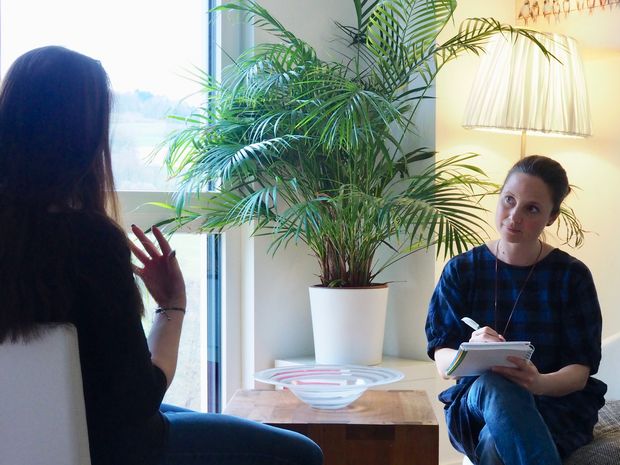Our psychologists have tips and advice on how to best unwind and decompress the mind and body during times of crises or other times in your life.

The second part of this series about relaxation practices focuses on methods that work on a more physical level and do not require consciously directing one's own thoughts.
1. How do physical relaxation techniques work?
Physical relaxation practices are based mostly on principles of tightening the muscles and then releasing. Actively engaging the body allows for the release of more energy and it becomes easier afterwards to loosen up and relax. By alternating between tightening the muscle and releasing, you relax muscle tone significantly and this can help you feel calmer and more refreshed. Rhythmic movement - such as jogging, swimming, walking, or cycling – is also a good way to feel more relaxed. If your body still needs more exercise, with a little practice you can learn specific, body-related relaxation practices. Today we would like to talk about and expand on some of the most important and proven practices.
2. Selected Relaxation Practices
Abdominal breathing is a key, essential part of many relaxation practices. It is easy to learn and can also be done quickly and relatively inconspicuously during study and work breaks or before exams. Abdominal breathing requires taking very deep breaths so that you actually see and feel your abdominal wall rise each time you inhale and fall each time you exhale. Focusing on exhaling helps the body to relax. Breathe in quickly and deeply but then exhale slowly and more relaxed. After exhaling, take a short breathing break before inhaling once again. At the start of the exercise, after the short breathing break, exhale shortly a second time. You should be taking about seven to eight deep breaths per minute and do the exercise for three minutes to feel more relaxed.
The practice of yoga also includes key elements such as breathing techniques and physical exercise. Yoga’s original, spiritual roots lie in Hinduism and Buddhism however, in western culture, the practice has been replaced by holistic ideas, meaning the desire to bring the body and mind together in harmony. There are various types of yoga practices combining different degrees of physical exercise (asanas) with meditative, relaxation, and breathing exercises. In western usage, more body-oriented yoga practices are summarized under the concept of Hatha Yoga.
Our Tip: If you have never done yoga before, we recommend attending special beginner’s classes. You can find these courses online, even during the current pandemic.
Online videos on yoga and yoga classes, among other things, are available at:
https://www.youtube.com/channel/UCHJBoCDxaCTRrwCHXEBA-BA, opens an external URL in a new window
https://www.youtube.com/user/yogawithadriene/videos, opens an external URL in a new window
http://ashtangayogalinz.at/, opens an external URL in a new window
In 1929, American physician Edmund Jacobson created progressive muscle relaxation (PMR) which practices consciously and voluntarily tensing and then relaxing individual groups of muscles in order to achieve a holistic state of deep relaxation. Suggestive elements are completely avoided.
Over the years, practitioners developed shorter versions of progressive muscle relaxation techniques. A frequently used technique by Bernstein and Borcovec requires tensing up four to sixteen muscle parts for five to seven seconds in a predetermined sequence and then releasing for 45 to 60 seconds.
Progressive muscle relaxation aims to improve the body’s perception and identify the slightest signs of tension as well as be able to relax individual groups of muscle in a more targeted way. Cognitive practices to overcome fear and stress also use this basic principle. Practicing every day over a period of several weeks helps to deliberately generate a relaxation response, even during stressful or anxiety-inducing situations.
For those who have high blood pressure, spasms or neurological disorders, do not tense up your muscles but rather only imagine tensing them.
You can find instructions for progressive muscle relaxation techniques on an audio CD or online at:
Ohm, Dietmar: Stressfrei durch Progressive Relaxation, Mehr Gelassenheit durch Tiefenmuskelentspannung nach Jacobson, Trias Publishing (Audio CD)
Mayer, Karl C.: Entspannungstraining nach Jacobson, Progressive Muskelentspannung (Audio CD)
https://www.ksm.ch/de/fuer-patienten/audio/index.html, opens an external URL in a new window
3. You can learn how to relax and unwind
Start with body-related relaxation techniques slowly and carefully, trying not to force yourself to start in any way. It’s not about a maximum amount of tension, but rather it’s abpit developing a good overall physical feeling and, in the long run, consciously being able to relax, even during stressful situations. Taking part in (online) relaxation or yoga groups will help support regular practice and enable you to exchange experiences with others.
Our Tip: Experiment a little and try a different relaxation exercise each week.
Additional psychological and psycho-therapeutic support services
If you have questions about the relaxation techniques or are having any difficulties with the techniques, contact the Student Psychological Counseling Service Linz by phone or online.
Call 0732-2468-7930 for appointments for counseling sessions by phone or online.
We are available Monday to Thursday from 7.30 am - 3.30 pm and Friday from 7.30 am - 1.30 pm.








